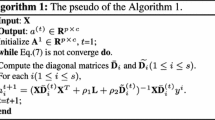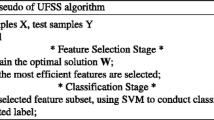Abstract
Feature selection and subspace learning are two primary methods to achieve data dimensionality reduction and discriminability enhancement. However, data label information is unavailable in unsupervised learning to guide the dimensionality reduction process. To this end, we propose a soft label guided unsupervised discriminative sparse subspace feature selection (UDS\(^2\)FS) model in this paper, which consists of two superiorities in comparison with the existing studies. On the one hand, UDS\(^2\)FS aims to find a discriminative subspace to simultaneously maximize the between-class data scatter and minimize the within-class scatter. On the other hand, UDS\(^2\)FS estimates the data label information in the learned subspace, which further serves as the soft labels to guide the discriminative subspace learning process. Moreover, the \(\ell _{2,0}\)-norm is imposed to achieve row sparsity of the subspace projection matrix, which is parameter-free and more stable compared to the \(\ell _{2,1}\)-norm. Experimental studies to evaluate the performance of UDS\(^2\)FS are performed from three aspects, i.e., a synthetic data set to check its iterative optimization process, several toy data sets to visualize the feature selection effect, and some benchmark data sets to examine the clustering performance of UDS\(^2\)FS. From the obtained results, UDS\(^2\)FS exhibits competitive performance in joint subspace learning and feature selection in comparison with some related models.










Similar content being viewed by others
Data and Code Availability
The Vote, Dermatology, Control, Yeast, and Ecoli data sets can be found from http://archive.ics.uci.edu/datasets. The Binalpha, PalmData25, MSRA25, and UMIST data sets can be found from http://www.escience.cn/system/file?fileId=82035. The source code for reproducing the experimental results in this work can be found in https://github.com/SunseaIU/UDS2FS.
References
Aibinu, A., Salau, H. B., Rahman, N. A., Nwohu, M., & Akachukwu, C. (2016). A novel clustering based genetic algorithm for route optimization. Engineering Science and Technology, an International Journal, 19(4), 2022–2034.
Ayar, M., Isazadeh, A., Gharehchopogh, F. S., & Seyedi, M. (2022). Chaotic-based divide-and-conquer feature selection method and its application in cardiac arrhythmia classification. The Journal of Supercomputing, 78, 5856–5882.
Brahim, A. B., & Limam, M. (2018). Ensemble feature selection for high dimensional data: A new method and a comparative study. Advances in Data Analysis and Classification, 12(4), 937–952.
Cai, X., Nie, F., & Huang, H. (2013). Exact top-$k$ feature selection via \(\ell \)2,0-norm constraint. In Proceedings of the International Joint Conference on Artificial Intelligence, pp. 1240–1246
Chao, G., Sun, S., & Bi, J. (2021). A survey on multiview clustering. IEEE Transactions on Artificial Intelligence, 2(2), 146–168.
Chen, X., Yuan, G., Nie, F., & Huang, Z. J. (2017). Semi-supervised feature selection via rescaled linear regression. In Proceedings of the International Joint Conference on Artificial Intelligence, pp. 1525–1531
Chen, X., Hong, W., Nie, F., He, D., Yang, M., & Huang, J. Z. (2018). Spectral clustering of large-scale data by directly solving normalized cut. In Proceedings of the ACM SIGKDD International Conference on Knowledge Discovery & Data Mining, pp. 1206–1215
Chen, X., Yuan, G., Nie, F., & Ming, Z. (2020). Semi-supervised feature selection via sparse rescaled linear square regression. IEEE Transactions on Knowledge and Data Engineering, 32(1), 165–176.
Deng, P., Li, T., Wang, H., Wang, D., Horng, S. J., & Liu, R. (2023). Graph regularized sparse non-negative matrix factorization for clustering. IEEE Transactions on Computational Social Systems, 10(3), 910–921.
Fang, X., Hu, Y., Zhou, P., & Wu, D. (2022). ANIMC: A soft approach for autoweighted noisy and incomplete multiview clustering. IEEE Transactions on Artificial Intelligence, 3(2), 192–206.
Gharehchopogh, F. S. (2023). Quantum-inspired metaheuristic algorithms: Comprehensive survey and classification. Artificial Intelligence Review, 56(6), 5479–5543.
Gharehchopogh, F. S., & Khargoush, A. A. (2023). A chaotic-based interactive autodidactic school algorithm for data clustering problems and its application on COVID-19 disease detection. Symmetry, 15(4), 894.
Gharehchopogh, F. S., Namazi, M., Ebrahimi, L., & Abdollahzadeh, B. (2023). Advances in sparrow search algorithm: A comprehensive survey. Archives of Computational Methods in Engineering, 30(1), 427–455.
Gharehchopogh, F. S., Ucan, A., Ibrikci, T., Arasteh, B., & Isik, G. (2023). Slime mould algorithm: A comprehensive survey of its variants and applications. Archives of Computational Methods in Engineering, 30(4), 2683–2723.
Greenlaw, R., & Kantabutra, S. (2013). Survey of clustering: Algorithms and applications. International Journal of Information Retrieval Research, 3, 1–29.
Gu, Q., Li, Z., & Han, J. (2011). Joint feature selection and subspace learning. In Proceedings of the International Joint Conference on Artificial Intelligence, pp. 1294–1299
He, X., & Niyogi P (2003). Locality preserving projections. In Proceedings of the Advances in Neural Information Processing Systems, pp. 153–160
Hou, C., Nie, F., Yi, D., & Tao, D. (2014). Discriminative embedded clustering: A framework for grouping high-dimensional data. IEEE Transactions on Neural Networks and Learning Systems, 26(6), 1287–1299.
Hu, B., Dai, Y., Su, Y., Moore, P., Zhang, X., Mao, C., Chen, J., & Xu, L. (2018). Feature selection for optimized high-dimensional biomedical data using an improved shuffled frog leaping algorithm. IEEE/ACM Transactions on Computational Biology and Bioinformatics, 15(6), 1765–1773.
Huang, J., Nie, F., & Huang, H. (2015). A new simplex sparse learning model to measure data similarity for clustering. In Proceedings of the International Joint Conference on Artificial Intelligence, pp. 3569–3575
Hubert, L., & Arabie, P. (1985). Comparing partitions. Journal of Classification, 2, 193–218.
Jia, Y., Nie, F., & Zhang, C. (2009). Trace ratio problem revisited. IEEE Transactions on Neural Networks, 20(4), 729–735.
Kamali, T., & Stashuk, D. W. (2020). Discovering density-based clustering structures using neighborhood distance entropy consistency. IEEE Transactions on Computational Social Systems, 7(4), 1069–1080.
Li, X., Jing, Z., Hu, B., Zhu, J., Zhong, N., Li, M., Ding, Z., Yang, J., Zhang, L., & Feng, L. (2017). Majoe D (2017) A resting-state brain functional network study in MDD based on minimum spanning tree analysis and the hierarchical clustering. Complexity, 9514369, 1–11.
Li, Z., & Tang, J. (2015). Unsupervised feature selection via nonnegative spectral analysis and redundancy control. IEEE Transactions on Image Processing, 24(12), 5343–5355.
Li, Z., Yang, Y., Liu, J., Zhou, X., & Lu, H. (2012). Unsupervised feature selection using nonnegative spectral analysis. In Proceedings of the AAAI Conference on Artificial Intelligence, pp. 1026–1032
Liyanage, Y. W., Zois, D. S., & Chelmis, C. (2021). Dynamic instance-wise joint feature selection and classification. IEEE Transactions on Artificial Intelligence, 2(2), 169–184.
Nie, F., Huang, H., Cai, X., & Ding, C. (2010). Efficient and robust feature selection via joint \(\ell \)2,1-norms minimization. In Proceedings of the Advances in Neural Information processing Systems, pp 1813–1821
Nie, F., Zhang, R., & Li, X. (2017). A generalized power iteration method for solving quadratic problem on the Stiefel manifold. Science China Information Sciences, 60(11), 146–155.
Nie, F., Dong, X., & Li, X. (2021). Unsupervised and semisupervised projection with graph optimization. IEEE Transactions on Neural Networks and Learning Systems, 32(4), 1547–1559.
Nie, F., Wang, Z., Tian, L., Wang, R., & Li, X. (2022). Subspace sparse discriminative feature selection. IEEE Transactions on Cybernetics, 52(6), 4221–4223.
Nie, F., Zhao, X., Wang, R., & Li, X. (2023). Adaptive maximum entropy graph-guided fast local discriminant analysis. IEEE Transactions on Cybernetics, 53(6), 3574–3587.
Pappu, V., & Pardalos, P. M. (2014). High-dimensional data classification. In Clusters, Orders, and Trees: Methods and Applications, Springer, pp. 119–150
Parida, P., & Bhoi, N. (2018). Fuzzy clustering based transition region extraction for image segmentation. Engineering Science and Technology, an International Journal, 21(4), 547–563.
Peng, X., Yu, Z., Zhang, Y., & Tang, H. (2017). Constructing the L2-graph for robust subspace learning and subspace clustering. IEEE Transactions on Cybernetics, 47(4), 1053–1066.
Peng, Y., Li, Q., Kong, W., Qin, F., Zhang, J., & Cichocki, A. (2020). A joint optimization framework to semi-supervised RVFL and ELM networks for efficient data classification. Applied Soft Computing, 97(106756), 1–15.
Peng, Y., Zhu, X., Nie, F., Kong, W., & Ge, Y. (2021). Fuzzy graph clustering. Information Sciences, 571, 38–49.
Peng, Y., Qin, F., Kong, W., Ge, Y., Nie, F., & Cichocki, A. (2022). GFIL: A unified framework for the importance analysis of features, frequency bands and channels in EEG-based emotion recognition. IEEE Transactions on Cognitive and Developmental Systems, 14(3), 935–947.
Piri, J., Mohapatra, P., Acharya, B., Gharehchopogh, F. S., Gerogiannis, V. C., Kanavos, A., & Manika, S. (2022). Feature selection using artificial gorilla troop optimization for biomedical data: A case analysis with COVID-19 data. Mathematics, 10(15), 2742.
Rand, W. M. (1971). Objective criteria for the evaluation of clustering methods. Journal of the American Statistical Association, 66(336), 846–850.
Song, P., & Zheng, W. (2020). Feature selection based transfer subspace learning for speech emotion recognition. IEEE Transactions on Affective Computing, 11(3), 373–382.
Sun, Y., Babu, P., & Palomar, D. P. (2016). Majorization-minimization algorithms in signal processing, communications, and machine learning. IEEE Transactions on Signal Processing, 65(3), 794–816.
Vu, V. Q., & Lei, J. (2013). Minimax sparse principal subspace estimation in high dimensions. Annals of Statistics, 41(6), 2905–2947.
Wang, K., He, R., Wang, L., Wang, W., & Tan, T. (2015). Joint feature selection and subspace learning for cross-modal retrieval. IEEE Transactions on Pattern Analysis and Machine Intelligence, 38(10), 2010–2023.
Wang, R., Bian, J., Nie, F., & Li, X. (2022). Unsupervised discriminative projection for feature selection. IEEE Transactions on Knowledge and Data Engineering, 34(2), 942–952.
Wang, R., Lu, J., Lu, Y., Nie, F., & Li, X. (2022). Discrete and parameter-free multiple kernel \(k\)-means. IEEE Transactions on Image Processing, 31, 2796–2808.
Wang, Z., Nie, F., Tian, L., Wang, R., & Li, X. (2020). Discriminative feature selection via a structured sparse subspace learning module. In IJCAI, pp. 3009–3015
Wu, T., Xiao, Y., Guo, M., & Nie, F. (2020). A general framework for dimensionality reduction of \(k\)-means clustering. Journal of Classification, 37(3), 616–631.
Ya, Geng, Li, Q., Liang, M., Chi, C. Y., Tan, J., & Huang, H. (2020). Local-density subspace distributed clustering for high-dimensional data. IEEE Transactions on Parallel and Distributed Systems, 31(8), 1799–1814.
Yan, H., Liu, S., & Yu, P. S. (2019). From joint feature selection and self-representation learning to robust multi-view subspace clustering. In Proceedings of the IEEE International Conference on Data Mining, pp. 1414–1419
Yang, X., Li, S., Liang, K., Nie, F., & Lin, L. (2022). Structured graph optimization for joint spectral embedding and clustering. Neurocomputing, 503, 62–72.
Yang, Y., Shen, H. T., Ma, Z., Huang, Z., & Zhou, X. (2011). \(\ell _{2,1}\)-norm regularized discriminative feature selection for unsupervised learning. In: Proceedings of the International Joint Conference on Artificial Intelligence, pp. 1589–1594
Yi, Y., Wang, J., Zhou, W., Zheng, C., Kong, J., & Qiao, S. (2020). Non-negative matrix factorization with locality constrained adaptive graph. IEEE Transactions on circuits and systems for video technology, 30(2), 427–441.
Zhan, K., Nie, F., Wang, J., & Yang, Y. (2019). Multiview consensus graph clustering. IEEE Transactions on Image Processing, 28(3), 1261–1270.
Zhang, X., Yao, Y., Wang, M., Shen, J., Feng, L., & Hu, B. (2017). Normalized mutual information feature selection for electroencephalogram data based on grassberger entropy estimator. In Proceedings of the IEEE International Conference on Bioinformatics and Biomedicine, pp. 648–652
Zhang, Y., & Cai, J. (2021). Fuzzy clustering based on automated feature pattern-driven similarity matrix reduction. IEEE Transactions on Computational Social Systems, 8(5), 1203–1212.
Funding
This work was supported by the National Key Research and Development Program of China under Grant 2023YFE0114900, the Natural Science Foundation of Zhejiang Province under Grant LY21F030005, and the National Natural Science Foundation of China under Grant 61971173.
Author information
Authors and Affiliations
Corresponding author
Ethics declarations
Ethical Approval
Not applicable
Conflict of Interest
The authors declare no competing interests.
Additional information
Publisher's Note
Springer Nature remains neutral with regard to jurisdictional claims in published maps and institutional affiliations.
Rights and permissions
Springer Nature or its licensor (e.g. a society or other partner) holds exclusive rights to this article under a publishing agreement with the author(s) or other rightsholder(s); author self-archiving of the accepted manuscript version of this article is solely governed by the terms of such publishing agreement and applicable law.
About this article
Cite this article
Chen, K., Peng, Y., Nie, F. et al. Soft Label Guided Unsupervised Discriminative Sparse Subspace Feature Selection. J Classif 41, 129–157 (2024). https://doi.org/10.1007/s00357-024-09462-6
Accepted:
Published:
Issue Date:
DOI: https://doi.org/10.1007/s00357-024-09462-6




